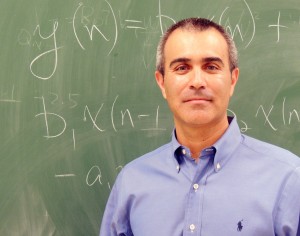Through the use of New Mexico State University’s High Performance Computing system, a supercomputer known as Joker, Phillip De Leon, associate dean for research in the College of Engineering, not only conducted research but students in his graduate electrical engineering course also utilized the system.
In the Pattern Recognition and Machine Learning course, which is a data science class De Leon taught in the fall, graduate students used Joker on projects that included developing machine learning codes and evaluating the models with standard datasets.
“These projects including identifying a song much like the Shazam app, recognizing handwritten digits like ZIP codes, classifying email as ham or spam, analyzing Twitter feeds, etc.,” De Leon said. “Being able to use this system allowed the students to experiment and tune their codes much faster since everything ran much faster. It also allowed for big datasets to be used in training and evaluation.”
“I used Joker to implement MatLab and Python scripts that had large datasets for my machine learning class,” said Jennifer Hu, electrical engineering master’s student. “It was faster and more efficient to implement it on Joker than on my MacBook Pro or my office computer.”
“I remember running my first Python script on Joker. My friends ran a MatLab script on the lab computers,” she added. “I chose to run Python because MatLab wasn’t installed on Joker, yet. Instead of waiting at least 70 hours for a program to finish in MatLab, mine took less than five minutes to complete. It was incredible.”
De Leon used Joker for other machine-learning codes he has developed for research. Working with Bob Wood, kinesiology professor, David Keeley, biomechanics assistant professor, and Matthew Martinez, engineering Ph.D. student, De Leon used Joker to train a classifier that can predict if an elderly person is at risk for falling.
“I wrote a mobile app to use the inertial measurement unit of a smartphone to log motion data, and we use the app to collect data when a person walks,” De Leon said. “We process the signals from hundreds of people where we already know their risk and feed this data into a code that we developed. That code learns patterns that can discriminate between people at risk and not at risk. Once the system is trained, we can present it new data and allow it to make predictions.”
Additionally, De Leon is using Joker for speech processing research. “I hope to use Joker in the future to run codes for deep convolutional neural networks (CNNs) and recurrent neural networks (RNNs) that I am beginning to work with. These deep CNNs are behind the apps that do speech recognition such as Apple Siri, Amazon Alexa and OK Google, language translation and image recognition. I’m learning to work with them for signal processing and analyzing human motion.”
De Leon said using the supercomputer was surprisingly easy and credited the Information and Communication Technologies staff including Piyasat Nilkaew, Diana Toups Dugas and Matt Henderson for their assistance.
“They gave us good direction on scheduling compute jobs and installed software packages and libraries that we needed,” he said.
Current NMSU students, faculty and staff can use ICT’s Supercomputing resources for free. For more information visit http://hpc.nmsu.edu.

